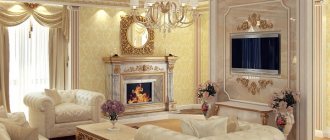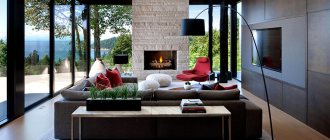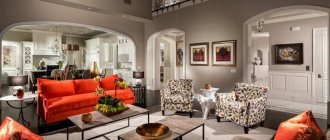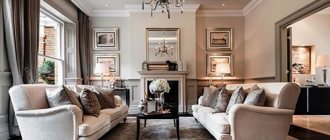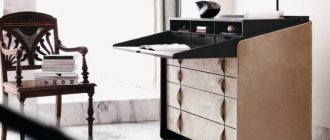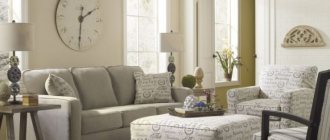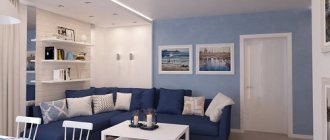The classics constantly acquire new features, and thanks to this they remain relevant to this day. The interior in a classic style is quite practical, but not prim and creates the impression of elegance. The inherent laconicism of the classics will not allow the room to be cluttered with unnecessary objects and decorations. If you have a desire to furnish your living space in the style of modern classics, first familiarize yourself with the basic components of this style.
Bedroom design in turquoise color
The combination of classic and modern will look winning
The design of the living room is made in the same style
Characteristics
Each era and country had its own ideas about the traditional classical style. Therefore, there are several such styles - antique, gothic, renaissance, baroque, modern.
Almost always, when they talk about classicism, they mean a monumental and representative style with an abundance of expensive wooden furniture, expensive fabrics, complex and lush draperies, elegant and expensive wall and floor decoration, spacious rooms with high ceilings, stucco moldings, bas-reliefs, columns, expensive paintings and works of art.
Classicism in the traditional sense emerged in the art of interior design at the beginning of the twentieth century. To some extent, classicism is a counterbalance to modernity with its abundance of non-functional decorative elements and excessive pomposity. Classicism is characterized by restraint and rigor, as well as significant simplicity of lines (especially when compared with Baroque, Renaissance, and Art Nouveau).
Points of contact
The classic interior style, formed back in the 16th-18th centuries, does not lose its relevance today thanks to its aristocracy, sophistication and rigor. It absorbed the best of Baroque, Rococo and Empire style. There is no place for artificial and cheap materials. Accessories are selected with an emphasis on historical or cultural value.
The modern style or contemporary arose much later - in the second half of the twentieth century. He took the focus on a functional and practical space without frills. Minimalism, modernism, high-tech and eco-style contributed to its formation. Unlike the classical trend, contemporary art allows the use of inexpensive artificial materials, simple and functional furniture, and minimalist decor.
Despite the difference of almost four centuries, these two directions still have a lot in common: pastel light shades, a single color scheme, clear lines, a desire for symmetry, elegance and space. The unifying features will become the starting points for style combinations.
Style transformation
Classic never goes out of style. The basic principle of modern classics is discreet elegance. This style combines the best ideas of many eras and trends in interior design. Modern classics in the interior are associated with prestige and wealth (one might say luxury). People who choose neoclassical interiors are characterized as successful and sensible adherents of traditions.
Neoclassicism in a modern interior is a compromise between the principles of classicism and the realities of today. Classic in the traditional sense of style requires significant investments, expensive materials, sophisticated finishes, very spacious rooms, luxurious furniture and works of art. Therefore, the classic interior in modern houses and apartments is a discreet stylization on the theme of the classics.
Furniture in neoclassical style
It is impossible to save on furniture when decorating such an interior. Preference is given to models made from natural materials, with a base of the correct geometric shape, rounded backs of sofas, armchairs, curved legs of poufs, chests of drawers, and tables raised above the floor. There should not be a lot of furniture in such an interior, since it is necessary to save more free space, that is, its functionality and capacity are also important.
The facades of large objects - living rooms, kitchen units, cabinets - must necessarily reflect light and include transparent glass planes, creating additional volume in the interior. In addition, decoration and decor of furniture from
- expensive textiles;
- genuine leather;
- forged elements.
If a dining room or dining area is designed in the living room or spacious kitchen, then chairs with high backs must be present. The neoclassical style bed is large, massive, on carved legs, with a high headboard, upholstered in expensive fabric.
The wall for the living room should include display modules - pencil cases for books, sideboards for dishes. In small apartments they can be replaced by sets with matte facades, complemented by mirror inserts.
It is not enough to choose the right furniture; it is also important to place it correctly. Only professionals in the field of interior design can take into account every detail while maintaining the style.
Features of neoclassicism
Main characteristics of modern classics:
- spacious and bright rooms;
- use of natural materials, especially natural wood;
- furniture of traditional restrained forms, without unnecessary decorations and carvings;
- simple form of furniture, the presence of mirrors, glass;
- absence of eccentric elements of furniture and decor;
- discreet atmosphere, but not a minimalist interior;
- the presence of elegant decorations - paintings, lamps, sconces, sculptures, vases, clocks.
Combination of classic and modern style
Authors of the project: Alexander Kutsenko, Yulia Mikhailova. Photo: Vitaly Nefedov
Authors of the project: Alexander Kutsenko, Yulia Mikhailova. Photo: Vitaly Nefedov
The author of the project, Yulia Mikhailova, says: “We were faced with two main tasks: to preserve the feeling of air in the space and to make the high-status interior in tune with global fashion trends. We decorated the open space of the main zone with classic decorative elements, but in a modern, laconic interpretation. We complemented the bright black and white contrast in the decoration with fresh flowers and walnut root furniture. This is how the right balance was found between classic and modern style.”
Special requirements
The main requirement for a room in which it is planned to decorate the interior in a neoclassical style is the presence of a sufficiently large area and a ceiling height of at least 3 m. In a small room (less than 20 m2), all the beauty and elegance of the interior will simply be lost.
The second requirement is large windows. Not necessarily modern panoramic ones, but not the small and narrow “loopholes” that are sometimes found in Stalin buildings.
The third requirement is a sufficient width of the room. Preferably from three and a half meters.
A combination of classic and contemporary
The author of the project is Victoria Lazareva. Photo: Alexander Shevtsov
The author of the project is Victoria Lazareva. Photo: Alexander Shevtsov
The owners of this apartment wanted something bright and extraordinary. The author of the project, Victoria Lazareva, created for them an interior filled with color and mysticism, in which she combined the traditions of English classics and the features of modern contemporary. A unique atmosphere is created by objects of art invented specifically for this project.
Principles for choosing furniture
With a neutral wall color, cabinet furniture plays first fiddle in the design. Cabinets and cabinets, tables and chairs in any classic style should be made of solid wood (not pine) or covered with veneer. The natural beauty of wood cannot be replaced by anything. It is highly undesirable to use furniture with a plastic coating that imitates the texture of natural wood. Elements of high-tech style are completely unacceptable: glass tables and metal furniture, especially with shiny nickel-plated elements.
Sofas and armchairs should be of a simple, laconic shape, with smooth curves, not too bulky, and not pretentious in shape. Furniture can be quite massive on short modern legs and in a traditional classic style: compact armchairs and sofas on tall wooden legs of a simple shape. Upholstery in discreet colors; it is possible to use striped furniture fabrics for traditional furniture with legs.
Interior design in modern classics. Ideas for apartment planning solutions
Open plan, conditional zoning, expanded functionality - all this is about the neoclassical style in the interior. The photo below shows examples of popular and very interesting compositional and planning solutions for apartments, with which you can create a beautiful and comfortable living space.
Dining area on the podium in the kitchen-living room
All photos In the photo: Dining room on the podium in the living room of a Domodedovo apartment
As a rule, decorators use a pendant lamp to highlight the dining area in the interior of the living room. But the designers of the Angelika Prudnikova Studio found a more spectacular and unusual solution - they designed a podium for the dining group, which is a continuation of the kitchen floor. It was integrated into the interior with the help of a white high plinth, so that the composition was completed.
9. Traditional sofa area
All photos In the photo: Sofa area in the living room on Mosfilmovskaya
A light set of upholstered furniture, consisting of two sofas and an armchair with an original “edging” made of dark wood, is a traditional solution for a living room in the neoclassical or art deco style. By placing them around a stylish coffee table, the designers of the Angelika Prudnikova Studio created a harmonious relaxation area in a multifunctional living room.
Neoclassicism in the interior of a kitchen with an island. Photo 2018
All photos In the photo: Kitchen with an island in the style of modern classics
A compact island in a kitchen decorated in the style of modern classics is more than appropriate. It will perfectly complement the corner set and can be used as an additional work surface, serving table or bar counter. In order for the island to fit organically into the interior composition, its design should be as laconic as possible, and the countertop should be made of the same material as the work surface (in the kitchen in the photo it is exclusive chocolate-colored marble).
Seating area with corner sofa
All photos In the photo: Living room with a corner sofa in Zelenograd
A white corner sofa with rounded armrests is just a godsend for a neoclassical kitchen-living room. This model will solve several problems at once: it perfectly organizes space in the recreation area and unobtrusively zones the room. And one more important point: the corner sofa does not need companions, so you can dispense with armchairs.
Mini library
All photos In the photo: Living room with narrow bookshelves
For a small apartment where it is not possible to arrange a separate office with a library, tall and narrow bookshelves would be an excellent solution. They can be equipped on both sides of the window, supplemented with lighting and combined with the surrounding environment using a decorative molded cornice.
Boudoir area in the bedroom
All photos In the photo: Neoclassical bedroom with a boudoir area in the Krylatsky residential complex
A boudoir area in the bedroom is convenient and practical. It can be used for its intended purpose or as a compact workstation. The main thing is to choose a dressing table that suits the design and a comfortable chair. And if there is no free corner in the room, the boudoir area can be located at the foot of the bed - next to the chest of drawers or TV.
Portal between kitchen and living room
All photos In the photo: Portal between the kitchen and living room in the residential complex “Club House on Tchaikovsky”
In the tradition of the classics, the separation of the kitchen and living room. But the neoclassical interior in the photo is a completely different matter. Here the living room smoothly flows into the kitchen due to a wide portal that visually unites the two rooms. And to make this “border” even more blurred, the designers of the Angelika Prudnikova Studio decorated the end part of the portal with mirror tiles.
Dining room in the center of the studio kitchen-living room
All photos In the photo: Dining room in the passage area of the apartment in the Rozmarin residential complex.
The studio layout of the public area of the apartment in the Rozmarin residential complex made it possible to place all functional areas as ergonomically as possible. The kitchen, separated from the rest of the space by a bar counter, is located at the end wall, the living room is closer to the hall, and the dining room is strictly between them.
Color spectrum
Classic means restrained light colors: white, beige, gray, golden, coffee, sand, light brown. Sometimes pastel blue, salad, lemon, milky tones. Dark colors are not used. Aggressive colors are not used: red, coral, orange. Cherry - only in accents. It is not customary to decorate a classic interior in lilac and purple tones. Golden color can be used in decorations.
The floors are natural colors of wood or stone. No unnatural colors - green, blue, red.
The ceiling is always traditionally white.
Classic with modern details
The author of the project is Alexandra Helminskaya-Leontyeva. Photo: Dmitry Chebanenko
The author of the project is Alexandra Helminskaya-Leontyeva. Photo: Dmitry Chebanenko
The owners of this Moscow apartment, an adult couple, initially wanted a purely classic interior. But in the process of work, it turned out that they were uncomfortable staying within the confines of one style. Then the author of the project suggested diluting the design with modern details. As a result, the interior looks calm, restrained and relevant.
Finishing materials
A characteristic feature of the classic style is the absence of plastic coverings, glass countertops, metal furniture, counters and structures made of nickel-plated metal.
Floor
It is difficult to imagine a modern classic interior without parquet. In this style, budget linoleum, artificial laminate, and just a board, even from exotic woods, are inappropriate. The parquet should not be too dark or light straw. Only natural wood tones of medium color saturation.
A possible option is natural stone or tiles. Such a covering is sometimes installed in houses with a “warm floor” heating system. It is not advisable to use black stone.
Walls
Luxurious Venetian plaster is quite appropriate for walls. Painting with water-based paints is not recommended. Embossed non-woven wallpaper with painting, smooth or striped vinyl look good. There should be no drawings, flowers, or even larger abstract graphics on the wallpaper. Under no circumstances should loft elements (brick walls) or textured plaster be used in a classic interior.
Walls are often decorated with moldings (cornices). You can use imitation columns with moderately complex stucco at the top.
In traditional classical styles, walls were often covered with painted white panels, decorated with moldings or milling in the form of panels. Nowadays this design is rarely used. Do not use fabric covering panels or fabric wallpaper, especially with a pattern.
Ceiling
The ceiling in classic interiors is white - traditionally painted or stretched. Stretch ceilings should be matte, in no case glossy or satin. Sometimes it is appropriate to place a stucco rosette on the ceiling under a chandelier (without gilding!)
If the ceilings have two or three tiers, they should be of a simple shape; the best option is to follow the shape of the ceiling. There should be no bright colors, mirrors, dark inserts, photo printing, dark canvases, or Swarovski crystals. Diffuse lighting of the ceiling or a “floating” ceiling is possible.
Classic and modern design techniques
The author of the project is Anastasia Sizova. Photo: Evgeniy Luchin
The author of the project is Anastasia Sizova. Photo: Evgeniy Luchin
Classic design is organically combined in this interior with modern techniques: a bold palette and unusual art objects. So, in the bedroom, the classic is clearly visible, but the unusual color of the walls and bright wall decor, which the customer agreed to, present it in a more daring, modern way.
Decor and lighting
Lighting fixtures play a very important role in creating a classic interior. The presence of a chandelier and sconce in neoclassical style is mandatory. The most traditional ones are chandeliers and sconces with gilded fittings and bronze fittings. Simple painted fittings are allowed, for example, white, black. Under no circumstances should nickel-plated structures be used.
Lampshades and lampshades can be white, matte or transparent, closed or open. It is allowed to use crystal lampshades - a very simple, laconic shape and large parts, with a small number of pendants. Chandeliers assembled entirely from crystal beads and pendants are not compatible with a classic interior. Lampshades should not imitate flowers.
In a classic interior, decor plays a very important role. Modern applied delights are not used here - real paintings in beautiful frames should hang on the walls. And expensive watches. And no flowers in hanging pots.
Bronze sculptures are very welcome. And beautiful vases. But it is important not to overdo it with the quantity.
A showcase with a collection of art objects, luxurious dishes, and exotic souvenirs will serve as a wonderful decoration of the classical style.
In classic interiors, blinds are not used. The best choice is a beautiful, moderately complex drapery made from expensive fabric.
Mix of classics and minimalism
Authors of the project: Natalia Polyakova, Kirill Parmon.
Photo: Alexandra Terentyeva Authors of the project: Natalia Polyakova, Kirill Parmon. Photo: Alexandra Terentyeva
A leather sofa, dark wood, characteristic accessories - all these are elements of a classic style. And at the same time, the interior looks very modern. The effect is achieved through the choice of simple, laconic forms characteristic of minimalism.
Timely upgrade
There has long been a tendency in the industry to restore old furniture in order to use it in a slightly modified form in new interiors. Therefore, chairs or a sideboard inherited from grandmother have the right to a new life. In the 20th century, original furniture was often produced, the forms of which have not yet lost their relevance: it is enough to update the armchairs or chairs by changing the upholstery and patching up the wounds on the wooden body, and a stylish element of the current interior is ready. Such an item will combine a classic form and modern upholstery - isn’t this a reflection of the essence of the entire interior in miniature.
After a particularly successful restoration, it is really difficult to understand what era a particular item belongs to. The interior with blue-blue walls is just an example of such an upgrade.
Bathroom design
— Is a similar curtain-wall in the bathroom considered a good alternative to a shower stall?
- This apartment has two bathrooms - the smaller one has a shower. Of course, such a curtain is much more elegant than hanging curtains with a pattern! However, it requires special care - if you are too lazy to wipe off drops of water every time, then limescale will not be long in coming. By the way, special rubber brushes with a handle - the so-called squeegees, window squeegees - do a very good job of cleaning up splashes.
Children's design
— How generally is it customary to take into account the interests of the child when it comes to decorating a nursery?
— Everything greatly depends on the parents-customers and the age of the child, but still you should not focus 100% on the “wants” of the younger family member, and especially when the task is to maintain the interior in the same style. The couple we worked with this time has a preschool-age son. In terms of technical specifications, this meant that it was necessary to provide a workplace, drawers and shelves for storing office supplies, a place for games and a place in the closet where toys and clothes could be hidden.
The couple we worked with this time has a preschool-age son. In terms of technical specifications, this meant that it was necessary to provide a workplace, drawers and shelves for storing office supplies, a place for games and a place in the closet where toys and clothes could be hidden.
Unity of forms
The shapes of objects can help create an original and comfortable interior. Select items in different styles, but with a similar shape and evoking similar associations. For example, an interior with a transparent Louis Ghost chair: a mirror in an antique carved frame, a console with graceful legs, elk antlers, a classic lamp and a modern plastic chair in the spirit of furniture from the time of Louis XVI combine perfectly with each other, creating a noble and at the same time non-trivial design.
Mixing styles in the design of one interior can be a solution for families in which one half stands for a modern style, and the other for a classic one. Eclecticism is not only a great way to create a fashionable design, but also to maintain harmony in family relationships.
We decorate the rooms
You can guess the design style of the apartment already in the hallway, which in the case of neoclassicism should be quite spacious
Living room
Let's start with choosing furniture. Usually, sofas and armchairs are chosen with simple shapes, but made from expensive, high-quality material. An important nuance: in addition to its aesthetic splendor, natural wood emits a characteristic smell, which will definitely add a special spirit to the overall atmosphere. It is allowed to have gilded legs on armchairs and sofas, as well as ornaments on the upholstery. The placement of interior items completely repeats the classic version: in the center there is a carpet on the floor, a table on it, and then all the other elements around the perimeter. As a rule, this is a large sofa, a couple of armchairs, and chairs with high backs. If room space and finances allow, install a fireplace.
The choice of furniture in the neoclassical style provides quite a lot of scope for creativity
Suede, velvet or velor material is found in the upholstery of sofas and armchairs
By the way, as an option, you can buy not expensive original furniture for the living room, but a worthy imitation of it. Today this is practiced quite often and can significantly reduce costs.
It is acceptable to install light, elegant models of upholstered furniture in a light shade with simple silhouettes
Lighting is another important aspect in decorating a neoclassical living room. There should be enough light (both natural and artificial). The main character, of course, will be a massive chandelier. Ideally, it should be a crystal structure, or forged with glass and crystal elements. The remaining luminous elements play a secondary role, but are in harmony with the leading “actress”. For example, floor lamps with voluminous lampshades, sconces located near the chairs, perhaps a table lamp. In neoclassicism there is an unspoken rule: there is never too much light.
In a neoclassical interior, it is advisable to use soft and diffuse lighting
Built-in lamps, floor lamps or sconces are used as auxiliary light
Accessories for a living room in a modern classic style will include vases, jugs, paintings, porcelain and ceramic figurines. And all this is not a matter of preference, but mandatory components of style.
Curtains on the windows should echo the walls or other elements of the room’s interior
Bedroom
The bedroom is one of the most important rooms in any house or apartment. After all, despite the fact that it is hidden from prying eyes, the peace of the owners depends on how comfortable it is decorated. Let's start with the design of the walls, ceilings and floors. Due to the fact that neoclassicism is often used for the design of small apartments, light colors in the decoration visually expand the room.
In neoclassicism it is customary to use the most expensive and innovative finishing materials
Neoclassicism is characterized by the following finishing techniques:
- painting the walls (ceiling) in one color;
- using wallpaper with small patterns or stripes;
- wood panels (or equivalent);
- glass wall panels or mirrors.
For ceilings, it is better to choose tension structures trimmed around the perimeter with decorative strips. The splendor of the interior will be emphasized by either a glossy ceiling without a pattern, or a matte design with a delicate print. If the ceiling is not very high, limit yourself to a single-level option. If the height of the room allows, install a multi-level structure.
Hidden LED lighting can be used as ceiling decoration
Parquet is traditionally chosen for the floor. But taking into account modern trends, you can give preference to laminate, or even poured flooring. Ceramic tiles, stylized as marble, fit very effectively into the bedroom interior.
Panoramic windows for neoclassicism are a true classic of the genre. Supplemented with decorative cornices or volumetric trims, such windows become the highlight of the overall design solution.
When planning the placement of lamps in a “neoclassical bedroom”, remember the general rule for this style: the main role is given to a spectacular chandelier, and all other lamps should “sing along” with it. The only caveat: you may decide not to purchase a very massive main chandelier for the bedroom so that it does not “eat up” the space. And arrange the rest of the lighting devices according to the multi-stage principle: sconces, floor lamps, table lamps. All light sources must be consistent with the general style: a forged base, a lampshade made of expensive fabric, or spectacular glass and crystal elements.
Despite the fact that the bedroom is intended for complete rest, it must accommodate different lighting scenarios
And, of course, the choice of sleeping place deserves attention. Modern classics provide a sufficient number of possible versions of this solution. As a rule, this is a rectangular bed with decent decoration. A spectacular headboard is, in a way, the calling card of such a bed. It can be either soft or ornately carved. A bed in a modern classic style is made of valuable wood, leather and expensive fabric.
The traditional solution is a comfortable bed with a soft headboard.
The obligatory “companions” of such a stylish bed will be bedside tables (they should be located symmetrically), a chest of drawers or dressing table with an elegant mirror, an easy chair (or maybe a sofa), and a wardrobe.
The number of pieces of furniture and their arrangement depends on the dimensions of the room
Classic design would not be such without worthy and appropriate decor. Typically, this function is performed by curtains made of natural silk, spectacular antique figurines, and paintings. Neoclassicism allows some liberties. In particular, the most varied decorations are chosen, and instead of paintings by great masters, the walls may well be decorated with modern images. Instead of natural silk fabrics, high-quality smooth fabric is used to decorate the window, matching the palette of decoration and furniture. Books on shelves, as well as vases with flowers and mirrors, even if not in antique frames, are considered a good decorative element.
One of the main elements of bedroom design are curtains made of thick fabric.
Kitchen
Most likely, the special atmosphere of neoclassicism will certainly be reflected in the quality of dishes prepared in such a kitchen. This is an ideal solution for those who would like to change something, but who are not ready for radical changes in the environment of their own home.
Neoclassical cuisine combines modern comfort with established traditions
In the middle of the kitchen you can place an additional work surface, which will be conveniently approached from all sides
A kitchen in a modern classic design is characterized by:
- pastel colors in decoration;
- use of moldings;
- carved decorative elements;
- exquisite fittings.
In this case, it is better to abandon gilding and volumetric stucco - the design is easier to perceive and looks more functional. Ideally, natural materials are used for finishing, but there are no strict rules and liberties are allowed: expensive natural stone can be replaced with decorative one, and let natural parquet give way to a more affordable laminate.
In furniture and decoration, a good imitation of natural materials is acceptable
However, a neoclassical kitchen should not contain the slightest sign of cost savings
The result should look chic, albeit without obvious frills, so it won’t be possible to decorate such an interior very cheaply
This interior does not tolerate diversity and excesses; everything is designed to be harmonious and appropriate. The priority is pastel colors: milky, ivory, gray and pale peach - these are ideal solutions for decorating the kitchen. An interesting feature: even simple kitchen sets in light colors look much more elegant than their dark “brothers” with lots of gilding.
A neoclassical kitchen should be furnished in colors characteristic of classic interiors
By the way, for the kitchen, as well as for other rooms, the use of white is also a great opportunity to artificially enlarge the room. Moreover, kitchen spaces, especially in apartments, do not have a large number of square meters.
An important detail: if you don’t want to decorate your kitchen exclusively in white, make it a combined one. White trim goes well with furniture in blue or beige colors.
Today there is no longer a need to choose between classic and modern; there is a good opportunity to combine both of these trends in the design of your own apartment or country house. Modern classics are a more democratic style compared to “pure” classics, and more restrained when compared with modern design trends. But the most important thing is that neoclassicism allows you to make your stay in the living room, bedroom or kitchen comfortable and enjoyable.
